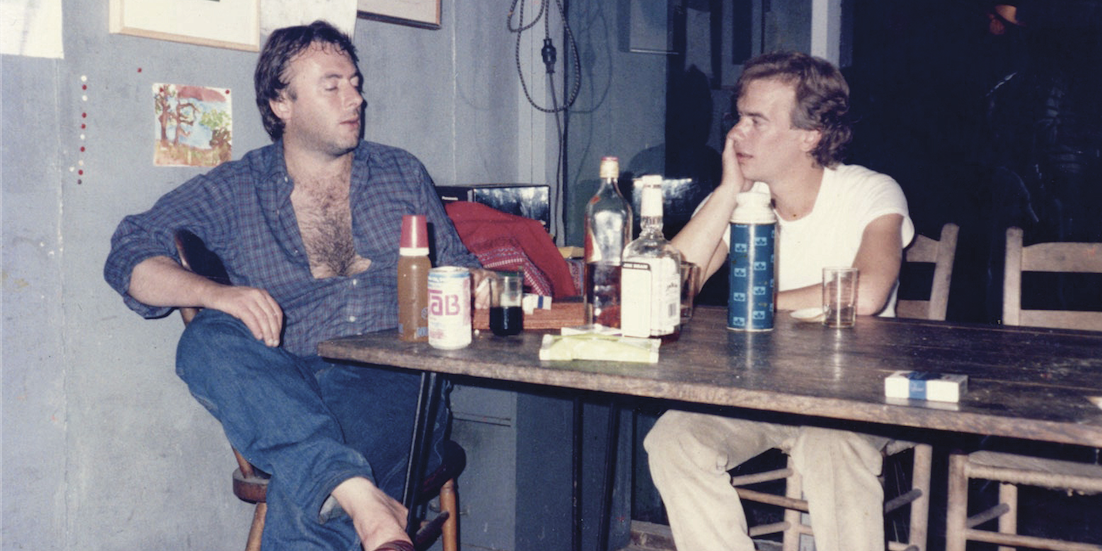THE UNNAMED NARRATOR of Lauren Oyler’s debut novel is an ex-blogger. She delivers hard truths about what she reads online: popular tweets and think-pieces alike are “aimed not at clawing for some difficult specificity but at reaffirming a widespread but superficial understanding.” Fake Accounts details her pivot to clawing, and to fiction; she is writing a semiautobiographical novel of hyperspecific circumstances, having recently discovered that her boyfriend, Felix, peddles anti-Semitic conspiracy theories via Instagram. Soon after, he dies. She gets the news at the Women’s March in Washington, DC, where she’s been biding her time at the dawn of the
- print • Mar/Apr/May 2021
- excerpt • January 21, 2021
I thought that in the interest of financial stability Nanae ought to increase her hours of part-time work rather than stocking up on lottery tickets.
- review • January 12, 2021
Claude McKay’s “lost” novel Romance in Marseille begins where most novels would end: with a twist of fate that brings life to a grinding halt. Lafala, a West African sailor and a man of “shining blue blackness,” is discovered stowing away on a ship traveling from Marseille to New York and detained in an uninsulated bathroom, where he nearly freezes to death. When he comes to, he’s in a New York hospital, legless. Lafala’s first reaction is fear: he has heard that doctors in hospitals sometimes kill Black patients to use as cadavers. This is not merely superstition, but the
- review • December 15, 2020
For every novel David Mitchell writes, two are published: there is the novel read by Mitchell’s fans, and the novel read by first-timers. Each of his books stands alone, as a thoughtful, researched, realistic portrayal of a specific time or place. There is a coming-of-age novel about a video-game obsessed adolescent in present-day Japan (Number9Dream), a novel about a Dutch visitor to a port near Nagasaki at the very end of the eighteenth century (The Thousand Autumns of Jacob de Zoet), a novel that deals with a widespread environmental collapse and the horror it brings to ill people (The Bone
- print • Dec/Jan/Feb 2021
YOU KNOW HOW, when you roll into a small town for the first time, in search of a slice of pie and a decent cup of coffee, you inevitably uncover a byzantine and nefarious criminal conspiracy, perhaps concerning Russian spies and Nazis? And your sense of justice and your MMA-style fighting skills demand that you stick around long enough to expose the evildoers, protect the innocent, and kick a whole lot of ass?
- print • Dec/Jan/Feb 2021
IN 1975, BREECE D’J PANCAKE was a twenty-three-year-old English teacher at Staunton Military Academy in the Shenandoah Valley. He was half a day’s drive from Milton, West Virginia, where he’d grown up. He hated the brutal, stultifying culture of the school, but the job was enough to support himself as long as he lived cheaply, which was important because his father had multiple sclerosis and could no longer work. His parents, Helen and C. R., said they were getting by, but he worried about their long-term financial security. Pancake was a loner, a dreamer, a contrarian, a depressive—in short, a
- print • Dec/Jan/Feb 2021
IN HIS THIRTEEN-LINE POEM “Scotland,” the Scottish poet Alastair Reid invokes a perfect day when “the air shifted with the shimmer of actual angels” and “sunlight / stayed like a halo on hair and heather and hills.” When the poet meets “the woman from the fish-shop,” he marvels at the weather, only to be told by her in the poem’s last line: “We’ll pay for it, we’ll pay for it, we’ll pay for it!”
- print • Dec/Jan/Feb 2021
IT IS CUSTOMARY TO START an essay about Kafka by emphasizing how impossible it is to write about Kafka, then apologizing for making a doomed attempt. This gimmick has a distinguished lineage. “How, after all, does one dare, how can one presume?” Cynthia Ozick asks in the New Republic before she presumes for several ravishing pages. In the Paris Review, Joshua Cohen insists that “being asked to write about Kafka is like being asked to describe the Great Wall of China by someone who’s standing just next to it. The only honest thing to do is point.” But far from
- print • Dec/Jan/Feb 2021
A MAN AND HIS FAMILY are vacationing in a tiny village in France. On the eve of their planned departure, the man’s wife and son disappear. He embarks on a hopeful search, asking for information about his missing family from neighbors and the local police. They went to pick up eggs and they didn’t come back, he tells anyone who will listen. But it’s September, and, with the other Parisian vacationers gone, the town—usually sunny and cheery—has transformed. It’s cold and wet, and the townspeople, once spirited and deferential to visitors, are distant and unhelpful. They are also confused by
- print • Dec/Jan/Feb 2021
LAURENCE STERNE DESIGNATED the poet and novelist Tobias Smollett a “Smelfungus” in his 1768 novel-length travelogue A Sentimental Journey Through France and Italy. Smollett published his travelogue Travels Through France and Italy two years before, and Sterne’s punishing evaluation of that work is as follows: “The learned Smelfungus travelled from Boulogne to Paris,—from Paris to Rome,—and so on;—but he set out with the spleen and jaundice, and every object he pass’d by was discoloured or distorted.—He wrote an account of them, but ’twas nothing but the account of his miserable feelings.” That judgment could equally apply to P. Lewis (aka
- review • November 19, 2020
ELENA FERRANTE DOES NOT require privacy. She lays out her psychosexual-emotional range for all the world in multiple languages. She does not lock down her time, although she controls its use: one written interview in each language with each book. What she avoids is the parade, the opportunity for outsiders to evaluate aspects of her she is not ferociously driven to present. That is why she wrote a letter to her publishers in 1991, before they released her first novel, Troubling Love, before she knew whether she would find one reader or one million. In the letter, she gently refused
- print • Dec/Jan/Feb 2021
“SENESCENCE” ISN’T QUITE THE RIGHT WORD for the stage the writers of the Baby Boom have reached. Sure, they may be collecting social security, the eldest of them in their mid-seventies, but the wonders of modern science may allow some another couple of decades of productivity. When the Reaper starts to come for the writer’s instrument, the first thing to go is flow, but that may not matter: fragments are in. In a decade or so, robbed of their transitions and reduced to accumulating prose shards, the octogenarian Boomers may find themselves newly trendy. A strange fate for a generation
- review • October 6, 2020
Authors have long asked whether fiction is useful in times of crisis, a question that has been especially pronounced in the past four years, following the election of the current president, the advent of coronavirus, and the killings of George Floyd and Breonna Taylor. What can a book do in a time like this? It’s a question central to Want, Lynn Steger Strong’s second novel. The narrator, unnamed until the penultimate page, asks herself throughout the book: Why did I study English? Why did I think that sharing books with people was a worthwhile way to spend my life?
- review • October 1, 2020
Most fiction about North Korea published outside of that country is by defectors and dissenters, and most of it tells of the hardships of living under a totalitarian regime. Fiction published in North Korea tends to be the opposite: when I visited in 2017, the only English-language books at the bookshop that passed as fiction were hagiographic historical novels about former supreme leaders.
- review • September 24, 2020
In today’s novels of disillusionment, every party has at least one person who doesn’t know why they’re there, who is thinking, as they find themselves on the periphery of various conversations: “Oh my god, everyone in this world is just way too interested in things.”
- review • September 22, 2020
In Nicole Flattery’s recent story collection, Show Them a Good Time, precarity is a draining certainty. Unlike the protagonists in Sally Rooney’s Conversations with Friends or Ottessa Moshfegh’s My Year of Rest and Relaxation, in which precarity is expressed as youthful malaise, Flattery’s characters experience money problems as a potentially endless catastrophe. Originally from Mullingar, Flattery is part of a generation of Irish writers whose adult lives have been defined by austerity. The all-female protagonists in Show Them a Good Time are stuck in this boom-bust loop. Hometowns are not the safety net they once were, and cities are cold
- review • September 17, 2020
In Katharina Volckmer’s debut novel, The Appointment, a patient sits in a medical exam room and monologues at a man named Dr. Seligman for 131 pages. The patient, Sarah, was born in Germany but is now based in London and likes to gossip about her former shrink, Jason, whom she hates. She isn’t sure whether she hates Dr. Seligman, though she initially distrusts him. She wonders if he’s like Jason, who would definitely smile his way “through any atrocity” with the ridiculous conviction that he could forgive all “petty human errors.” This raises an obvious question: if Sarah doesn’t trust
- print • Sept/Oct/Nov 2020
WHAT ARE THESE RED PILLS AND WHERE DO YOU GET ONE? They seem more potent than most non-metaphorical drugs. Just a single dose and you’ll never see the world the same way again. The term comes from The Matrix. Morpheus (Laurence Fishburne) presents Neo (Keanu Reeves) with a choice of two pills, a blue one that will allow him to live complacently within the illusion he’s used to (a fake life as a regular Joe with a family and an office job), or a red one (it looks like a Robitussin tablet) that will show him “the truth” (he’s really
- print • Sept/Oct/Nov 2020
HOW DO YOU WRITE A POLITICAL NOVEL IN 2020? How do you not write a political novel in 2020? It is impossible to imagine a contemporary writer presenting a version of the world that is not marked in some way by Trumpism, the threat of ecological catastrophe, the deepening gulf between the haves and the have-nots, the spectacle of racist police brutality. Yet the process of digesting the various horrors of the present into prose isn’t always noble. There is a way to use the novel as a balm to soothe the tempers of people who see themselves as opposed
- print • Sept/Oct/Nov 2020
“I PAINT THE PORTRAIT OF THE AGE,” the Austrian writer Joseph Roth proclaimed in a 1926 letter to his editor at the Frankfurter Zeitung. “I’m not a reporter, I’m a journalist,” he continued. “I’m not an editorial writer, I’m a poet.”



















